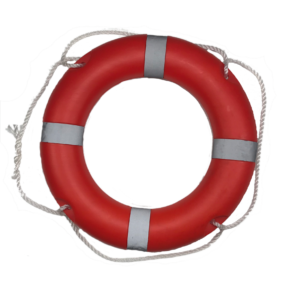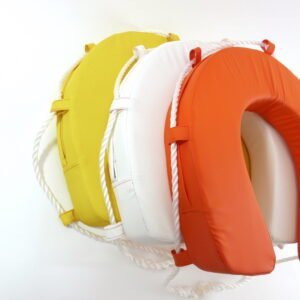Ensuring the right safety equipment, such as lifebuoys, is on board your boat is essential, especially when navigating British waters. In this article, we will provide an in-depth discussion of the different types of lifebuoys and the factors you need to consider when choosing the right one for your boat, in compliance with British regulations.
Types of Lifebuoys
Throwable Lifebuoys
These lifebuoys are designed to be easily thrown to a person in the water. They are typically smaller and more compact than other types of lifebuoys, featuring a built-in handle that makes throwing them easier. Throwable lifebuoys often come with a floating rope attached, allowing the person in the water to be pulled back to the boat.
Advantages: Easy to handle and throw, lightweight, suitable for small boats or personal watercraft.
Disadvantages: Limited buoyancy compared to larger lifebuoys, may not be suitable for rough sea conditions or larger vessels.
Horseshoe Lifebuoys

Horseshoe-shaped lifebuoys are popular among sailors because they can be easily attached to the deck of a boat. They provide a high level of support for the person in the water and are easy to use. These lifebuoys often feature straps and buckles that can be adjusted to fit the person in the water, ensuring a secure fit.
Advantages: Easy to store on board, adaptable to different body sizes, suitable for various water conditions.
Disadvantages: Bulky design, may not be as easily throwable as other types of lifebuoys.
Ring Lifebuoys

Ring lifebuoys are the most common type of lifebuoy, designed to provide buoyancy and support to a person in the water. They are usually larger than throwable lifebuoys and come in various sizes, making them suitable for different types of vessels. Ring lifebuoys often feature reflective material and bright colours for increased visibility in the water.
Advantages: High buoyancy, suitable for a wide range of boats and water conditions, increased visibility.
Disadvantages: Bulkier and heavier than throwable lifebuoys, may be harder to throw accurately.
British Regulations for Lifebuoys
ISO Standards
The International Organization for Standardization (ISO) has specific standards for lifebuoys, including their size, material, and design. When choosing a lifebuoy, ensure it complies with ISO 12402-4, which outlines the requirements for lifebuoys intended for use on recreational craft. These requirements cover aspects such as buoyancy, strength, and resistance to environmental factors.
SOLAS Compliance
For commercial vessels, lifebuoys must comply with the International Convention for the Safety of Life at Sea (SOLAS). SOLAS-compliant lifebuoys are designed to be more durable and reliable, making them suitable for use in harsher marine environments. They must also be equipped with a SOLAS-approved lifebuoy light, which ensures visibility in low-light conditions.
RYA Guidance
The Royal Yachting Association (RYA) offers guidance on the selection and use of lifebuoys. They recommend that all vessels carry at least one lifebuoy and that it should be readily accessible in case of an emergency. Additionally, they advise boat owners to select lifebuoys that are appropriate for the size of their boat and the number of people on board.
Factors to Consider When Choosing a Lifebuoy
Size
Lifebuoys come in various sizes, typically ranging from 24 to 30 inches in diameter. When choosing a lifebuoy, consider the size of your boat and the number of people on board. Larger boats may require larger lifebuoys to provide adequate buoyancy, while smaller boats may benefit from more compact, throwable lifebuoys. Keep in mind that larger lifebuoys may be more difficult to throw, so consider having a mix of sizes on board for different situations.
Material
Lifebuoys are typically made of polyethylene or PVC, which are both durable and resistant to UV radiation, saltwater, and temperature fluctuations. Choose a lifebuoy made from a material that is suitable for your boating environment. Polyethylene lifebuoys are generally more rigid and robust, making them suitable for harsher conditions, while PVC lifebuoys are more flexible and lightweight, making them easier to handle and throw.
Colour

Brightly coloured lifebuoys, such as orange or yellow, are easier to spot in the water, increasing the chances of a successful rescue. Choose a lifebuoy with a high-visibility colour, and consider adding reflective tape or a lifebuoy light to further enhance visibility in low light conditions.
Accessories for Lifebuoys
Lifebuoy Lights
Lifebuoy lights are essential for making your lifebuoy visible in low light conditions, such as during dusk or nighttime. Ensure your lifebuoy is equipped with a SOLAS-approved lifebuoy light, which has a minimum operational time of 2 hours and is designed to activate automatically when the lifebuoy is in the water.
Reflective Tape
Adding reflective tape to your lifebuoy can increase its visibility during nighttime rescues. Look for SOLAS-approved reflective tape when making your purchase, and apply it to the outer edge of the lifebuoy. This will help rescuers locate the lifebuoy more easily when using searchlights or torches.
Throwable Lines
Throwable lines can be attached to your lifebuoy, allowing the person in the water to grab onto the line and be pulled back to the boat. Choose a floating line that is strong and long enough for your needs, typically around 15 to 30 metres in length. Ensure the line is securely attached to the lifebuoy and that it is easily detachable from the boat when needed.
Maintenance and Inspection of Lifebuoys
Regular Checks
Inspect your lifebuoys regularly to ensure they are in good condition and ready for use in an emergency. Check for any signs of wear, damage, or deterioration, such as cracks, discolouration, or weakened attachment points. Replace any damaged lifebuoys immediately.
Cleaning and Storage
Clean your lifebuoys regularly to remove any dirt, algae, or salt buildup. Use a mild detergent and a soft brush to clean the surface, and rinse thoroughly with fresh water. Store them in a dry, well-ventilated area, away from direct sunlight and extreme temperatures, to prolong their lifespan.
Replacing Damaged Lifebuoys
If a lifebuoy is damaged or no longer fit for use, replace it immediately. Ensure you properly dispose of the damaged lifebuoy according to local regulations and environmental guidelines. Some recycling centres may accept lifebuoys made from certain materials, so check with your local facility for disposal options.
Choosing the right lifebuoy for your boat is essential for ensuring the safety of everyone on board. By considering factors such as size, material, and colour, and adhering to British regulations and guidelines, you can select the most suitable lifebuoy for your needs. Regular maintenance and inspection will ensure your lifebuoys are ready for use when needed, providing peace of mind during your time on the water.
FAQs
What is the minimum number of lifebuoys required on a recreational boat in the UK?
The RYA recommends that all vessels carry at least one lifebuoy, but you should consider carrying more depending on the size of your boat and the number of people on board.
Do lifebuoys have an expiration date?
Lifebuoys do not have a specific expiration date, but their condition should be regularly inspected to ensure they are fit for use. Replace any damaged or deteriorated lifebuoys immediately.
Can I use a lifebuoy as a personal flotation device?
Lifebuoys are not designed to replace personal flotation devices (PFDs) such as lifejackets. Both lifebuoys and PFDs serve different purposes and should be used in conjunction with each other for optimal safety.
What is the best way to store lifebuoys on my boat?
Lifebuoys should be stored in a readily accessible location on your boat, preferably in a lifebuoy holder or bracket. Ensure they are not obstructed by other equipment and can be easily deployed in case of an emergency.
How often should I inspect my lifebuoys?
It is recommended to inspect your lifebuoys at least once a month, or more frequently if they are exposed to harsh weather conditions or heavy use.
What accessories are recommended for lifebuoys?
Essential accessories for lifebuoys include SOLAS-approved lifebuoy lights, reflective tape, and throwable lines. These accessories enhance the visibility and functionality of the lifebuoys, increasing the chances of a successful rescue.
How do I choose the right size lifebuoy for my boat?
Consider factors such as the size of your boat, the number of people on board, and the conditions you will be navigating. Larger boats and rougher sea conditions may require larger lifebuoys, while smaller boats may benefit from more compact, throwable lifebuoys.
